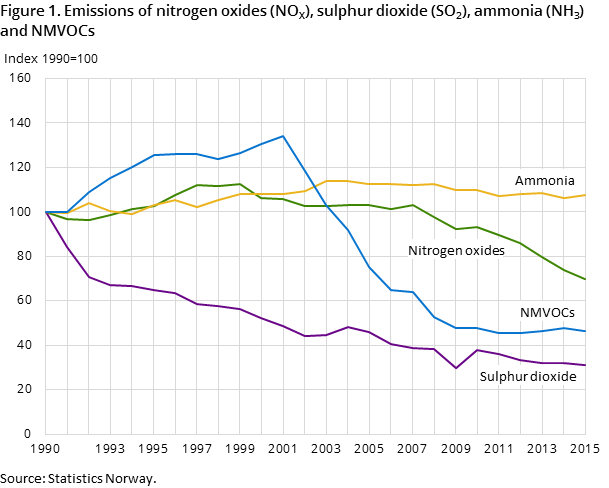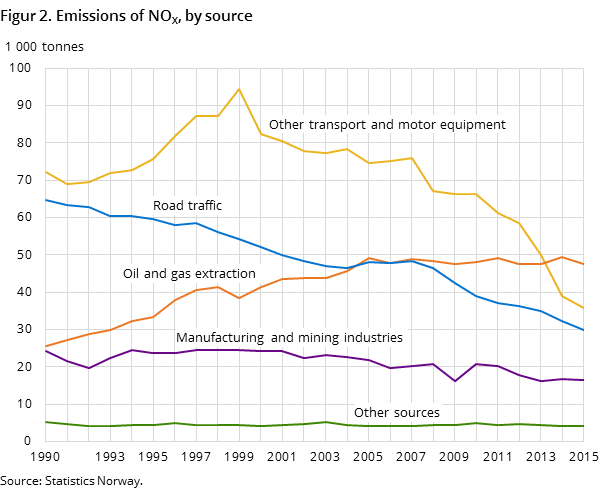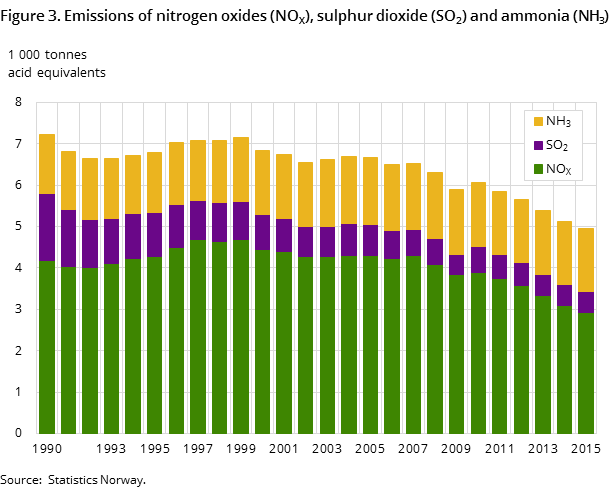Further decrease in nitrogen oxides emissions
Published:
In 2015, 134 100 tonnes of nitrogen oxides (NOx) were emitted in Norway. This means a continuation of the declining emission trend. The emissions were 5.4 per cent lower than in 2014, and well below the obligation in the Gothenburg Protocol of 156 000 tonnes.
- Full set of figures
- Emissions of acidifying gases and ozone precursors
- Series archive
- Emissions of acidifying gases and ozone precursors (archive)
The largest reduction has taken place in road traffic, but in oil and gas extraction there has also been a noticeable decline. This can be seen from the preliminary calculations of emissions from Norwegian territory for 2015. Sales of auto diesel were higher in 2015 than in the preceding year, but cleaner combustion in new diesel engines caused the emissions from road traffic to be reduced, and particularly for heavy vehicles. The drop in NOx emissions in oil and gas extraction is due to less use of marine diesel.
Continued decline in sulphur emissions
The emissions of sulphur dioxide (SO2) amounted to 16 200 tonnes in 2015, which is 2.8 per cent less than in 2014. The long-lasting declining emission trend continues, and the emissions were well below the obligation in the Gothenburg Protocol of 22 000 tonnes.
Increased ammonia emissions from agriculture
In 2015, 26 000 tonnes of ammonia (NH3) were emitted, which is 1 per cent more than in the preceding year. With that, the emissions were 13 per cent higher than the target of 23 000 tonnes that Norway has committed to. Agriculture is by far the largest contributor to ammonia emissions in Norway, and was responsible for 92 per cent of the total in 2015. The emission increase is mainly due to more fertiliser being used and a changeover to fertilisers with higher loss of NH3.
More carbon monoxide
The emissions of carbon monoxide (CO) rose by 1.8 per cent from 2014 to 2015, and amounted to 248 000 tonnes. The increase is mainly due to higher emissions from wood combustion, which is the largest contributor to these emissions. Emissions from petrol-powered vehicles were reduced.
Less NMVOC
In 2015, 134 000 tonnes of NMVOC gases were emitted, which is 3.1 per cent less than the preceding year. The decline is due to lower emissions from oil and gas extraction. The emissions of NMVOC have been well below the obligation of 195 000 tonnes for many years now.
Preliminary figures
Revised emission figures will be published in December 2016. The revised figures will contain more detailed classifications of source and industry.
Contact
-
Ketil Breckan Thovsen
-
Henning Høie
-
Statistics Norway's Information Centre



